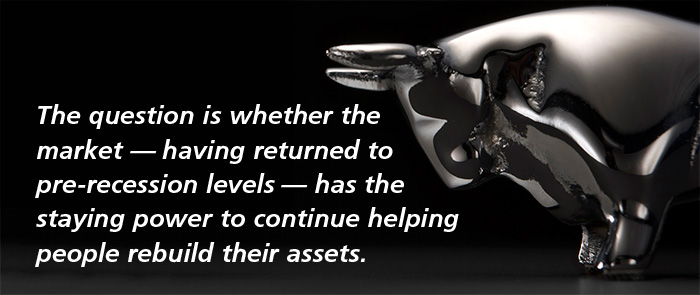On March 5, 2013, the Dow Jones Industrial Average closed at a record high of 14,253.77.¹ It took almost a month for the broader-based S&P 500 to follow suit, but it too set a new milestone when it closed at 1,569.19 on March 28.² Both indexes continued to set records into April, but amid the celebration on Wall Street there was caution and confusion as analysts puzzled over the charging bull market in an economy that is still struggling to pick up speed.³
By the time you read this, the market could be setting new records — or it might be on a downswing. Unfortunately, there is no way to predict the direction of the U.S. stock market. Even so, you might consider what the recent record-setting performance may suggest about the market and the broader economy.
Back Where We Started?
The Dow and the S&P 500 both set their previous records in October 2007 during a time of apparent prosperity.4–5 Real gross domestic product (GDP) had grown at an average annual rate of 3.6% and 3.0% in the second and third quarters of 2007, and the unemployment rate in October was 4.7%.6–7 Just two months later, the Great Recession began and the stock market lost more than half of its value by the time it hit bottom in March 2009.8–9
On one level, therefore, the recent records mean that the market has regained the value it lost over the past 5½ years. Theoretically — based on the Dow and the S&P 500 — investors who remained invested in the market may have regained the value of their stock portfolios.
That’s the good news. The bad news is that investors may have lost 5½ years of potential growth. The question is whether the market — having returned to pre-recession levels — has the staying power to continue helping people rebuild their assets.

Record Profits, Fewer Workers
The stock market is generally considered a leading indicator, meaning it may predict future economic trends. If true, the recent record performances would suggest that the economy may be picking up steam. Among the factors pushing stocks into record territory were expanding factory activity, higher spending by businesses and consumers, and signs of recovery in the housing market.10
In October 2007, however, the market did not seem to reflect the negative economic forces that were at work.
A key concern in the current situation is the economic disconnect between large American corporations and American workers — in part a direct result of the recession, which forced businesses to become more efficient and increase productivity with fewer employees.11
Since the end of 2008, corporate earnings have risen at more than a 20% average annual rate, while disposable income rose just 1.4% annually. In the third quarter of 2012, profits accounted for the highest share of national income since 1950, whereas wages as a percentage of income dropped to near the lowest point since 1966.12
Although the unemployment rate has improved, the 7.6% March 2013 figure is almost 3% higher than in October 2007.13 A leaner workforce may be good for the bottom line, but it remains to be seen whether American businesses can continue to grow with a high percentage of unemployed consumers.
Low Rates, Unforeseen Events
Low interest rates promoted by Federal Reserve monetary policies have also played a role in helping businesses grow in a sluggish economy.14 The Fed has committed to these policies until the unemployment rate drops to 6.5% and inflation appears poised to exceed 2.5%.15 So far, both benchmarks have remained out of reach, but some experts believe that rates may rise rapidly when the Fed finally loosens control.16
Of course, other factors could change the market direction. The European financial crisis continues to be a concern, and China’s lower-than-expected first-quarter 2013 GDP growth impacted global markets. Domestic events such as the Boston marathon bombing also affect stock performance and serve as a reminder that the future is uncertain.17
As you consider your own investments, it might be helpful to remember that market trends reflect expectations as much as economic reality, and expectations can change on a daily basis. Although records may be exciting, the wisest course is generally to maintain an investment strategy that is appropriate for your personal situation and risk tolerance.
The return and principal value of stocks fluctuate with changes in market conditions. Shares, when sold, may be worth more or less than their original cost. Both the Dow and the S&P 500 are unmanaged groups of securities, with the S&P 500 considered to be representative of the U.S. stock market in general. The performance of an unmanaged index is not indicative of the performance of any specific investment. Individuals cannot invest directly in an index. Past performance is no guarantee of future results. Actual results will vary.
1, 4, 9–10) The Wall Street Journal, March 5, 2013
2, 5) The Wall Street Journal, March 28, 2013
3) CNNMoney, April 11, 2013
6) U.S. Bureau of Economic Analysis, 2013
7, 13) U.S. Bureau of Labor Statistics, 2013
8) National Bureau of Economic Research, 2013
11–12, 14) The New York Times, March 3, 2013
15) Federal Reserve, 2013
16) The Wall Street Journal, March 11, 2013
17) CNNMoney, April 15, 2013

